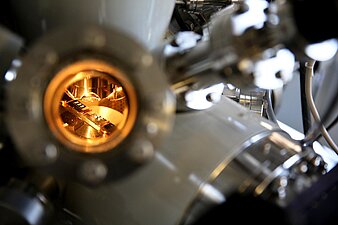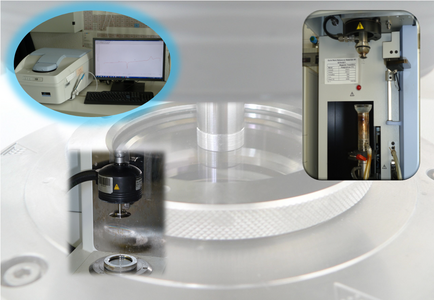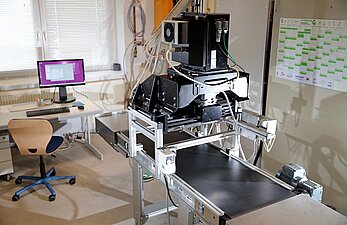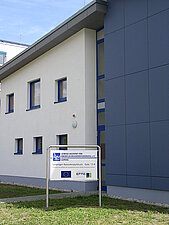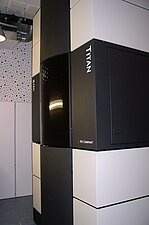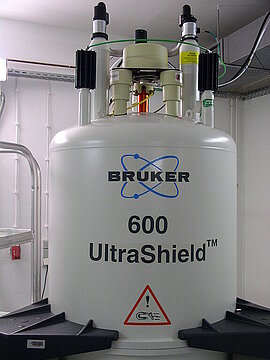The cross-section unit “Material characterization and Analytical service” provides the institute with a broad portfolio of instrumental methods to support all scientists at the IOM. A focus is set to surface-related analytical techniques. Therefor imaging methods show a huge versatility together with a high performance. Several additional techniques are available for the determination of the elemental and the chemical composition, the analysis of molecular, crystalline, and phase conditions as well as to characterize functional properties of materials. This includes the complex methods X-ray photoelectron spectroscopy, NMR spectroscopy and diffractometry. In close coordination with all colleagues, the possibilities of the group are continuously updated and expanded.
Expertise

Highlights
Orientation-dependent nanostructuring of titanium surfaces by low-energy ion beam erosion
Orientation-dependent nanostructuring of titanium surfaces by low-energy ion beam erosion
J. Bauer, F. Frost
Surf. Interface Anal. 52 (2020) 1071-1076
https://doi.org/10.1002/sia.6764Regular nanoscopic ripple and dot patterns are fabricated on poly‐crystalline titanium samples by irradiation with 1.5 keV argon ions at normal incidence. The morphology of the nanostructures is investigated by scanning electron microscopy and scanning force microscopy. The ripple structures exhibit a saw‐tooth cross‐section profile. Electron backscatter diffraction experiments are performed to analyze the local grain structure. The study suggests a distinct correlation of the nanostructure morphology to the crystallographic orientation of the titanium surface.
Near-infrared hyperspectral imaging for monitoring the thickness distribution of thin poly(3,4-ethylenedioxythiophene):poly(styrene sulfonate) (PEDOT:PSS) layers
Near-infrared hyperspectral imaging for monitoring the thickness distribution of thin poly(3,4-ethylenedioxythiophene):poly(styrene sulfonate) (PEDOT:PSS) layers
O. Daikos, M. Naumann, K. Ohndorf, C. Bundesmann, U. Helmstedt, T. Scherzer
Talanta 223 (2021) 121696
https://doi.org/10.1016/j.talanta.2020.121696The thickness of thin layers of the conductive polymer PEDOT:PSS in the range between about 60 and 300 nm was determined by a near-infrared spectroscopic method using a hyperspectral camera. The reflection spectra of the layers do not contain bands, but consist of a moderate slope of the overall reflectance in the range between 1320 and 1850 nm. Despite the low thickness, the spectra show an extremely strong dependence on the thickness of the layers, which allows their use for quantitative measurements. The prediction of quantitative thickness data from the reflection spectra was based on a chemometric approach using the partial least squares (PLS) algorithm. Calibration was carried out by means of spin-coated layers of PEDOT:PSS, whose thickness was determined by white-light interferometry and stylus profilometry. Finally, this resulted in a calibration model with a root mean square error of prediction (RMSEP) of about 9 nm. After external validation of this model, it was used for quantitative imaging of the thickness distribution in PEDOT:PSS layers. The precision of the predicted values was confirmed by comparison with data from the reference methods. Moreover, it was shown that this approach can be also used for hyperspectral imaging of the thickness of thin printed layers and structures of this conductive polymer on polymer film or paper with excellent thickness resolution. This analytical approach opens new possibilities for in-line process control by large-scale monitoring of thickness and homogeneity of thin layers of conductive polymers.
Monitoring of the residual moisture content in finished textiles during converting by NIR hyperspectral imaging
Monitoring of the residual moisture content in finished textiles during converting by NIR hyperspectral imaging
O. Daikos, T. Scherzer
Talanta 221 (2021) 121567
https://doi.org/10.1016/j.talanta.2020.121567Hyperspectral imaging was used for large-scale monitoring of the residual moisture in wide textile webs at the end of the drying process that follows their washing or finishing by impregnation in aqueous solutions or dispersions. Such data are essential for optimizing the energy efficiency and the precise control of the drying process. Quantitative analysis of the recorded spectral data was carried out with multivariate regression methods such as the partial least squares (PLS) algorithm. Reference data for calibration of the prediction models were determined by gravimetry. The drying of textile materials from both natural or synthetic fibers possessing different water absorption capacities (cotton, polyamide, polyester), which were partially finished with an optical brightener, was investigated. Moisture contents in the range from 0 to about 12 wt% were considered in the calibration models. For all systems, the root mean square error of prediction (RMSEP) for the residual moisture was found to be about 0.5 wt%, that is, about 1 g/m2. In addition to the quantitative determination of the water content, hyperspectral imaging provides detailed information about its spatial distribution across the textile web, which may help to improve the control of the drying process. In particular, it was demonstrated that the developed methods were capable of detecting and visualizing inhomogeneous moisture distributions. Averaging of the individual values of the moisture content predicted from all spectra across the surface of the textile samples resulted in a very close correlation with the corresponding gravimetric reference values. Due to the averaging process, the difference between both values is generally lower than RMSEP even in case of samples with inhomogeneous distribution of the moisture. The high precision and the broad capabilities of the developed analytic methods for in-line monitoring of the moisture content hold the potential for an efficient process control in technical textile converting processes.
Interconnected electrocatalytic Pt-metal networks by plasma treatment of nanoparticle-peptide fibril assemblies
Interconnected electrocatalytic Pt-metal networks by plasma treatment of nanoparticle-peptide fibril assemblies
J. Bandak, J. Petzold, H. Hatahet, A. Prager, B. Kersting, Ch. Elsner, B. Abel
RSC Adv. 9 (2019) 5558-5569
https://doi.org/10.1039/C8RA08201DNoble metal catalysts possess outstanding catalytic behaviors in organic reactions, photocatalysis, electrocatalysis and many other applications. Peptide fibrils are used for the controllable nanostructuring of metal nanoparticles with specific sizes, shapes and high-surface area structures. The degradation of these fibrils with O2-plasma yields interconnected networks of nanoparticles, similar to metallic nanowires. Herein, platinum nanoparticles (Pt-NPs) were synthesized by reduction using VUV excimer radiation. The particle size was characterized by dynamic light scattering (DLS). Due to agglomeration, the metal nanoparticles were stabilized using poly(vinyl pyrrolidone) (PVP) and the same synthesis procedure. The influence of the polymer PVP molecular weight (Mwt), PVP concentration (Cp) and VUV irradiation time on platinum nanoparticle size was investigated. Small (2–3 nm) Pt-NPs are formed in the case of PVP with Mwt = 10 000 g mol−1. With increasing PVP Mwt, decreasing PVP concentration and shorter irradiation times, larger sized nanoparticles appear. The applicability of templated platinum nanoparticles, both the PVP-stabilized and non-stabilized Pt-NPs, immobilized via electrostatic interactions on the solid phase-synthesized aniline-GGAAKLVFF (AFP) peptide fibrils was investigated to serve as possible electrode material. The plasma treatment of the nanoparticle-fibril-assemblies was also studied as a novel technique. The Pt-NPs-AFP fibrils and the PVP-stabilized-Pt-NPs-AFP fibrils nanohybrids were employed to modify electrodes and then subjected to O2-plasma treatment. These O2-plasma treated/modified electrodes exhibited high electrocatalytic activities towards oxygen reduction in cyclic voltammetry measurements. Thus, the aforementioned nanocomposites hold great potential for polymer electrolyte fuel cells and other electrochemical applications in miniature devices and microfluidic chips.
Controlling the fluorescence properties of nitrogen vacancy centers in nanodiamonds
Controlling the fluorescence properties of nitrogen vacancy centers in nanodiamonds
C. Laube, T. Oeckinghaus, J. Lehnert, J. Griebel, W. Knolle, A. Denisenko, A. Kahnt, J. Meijer, J. Wrachtrup, B. Abel
Nanoscale 11 (2019) 1770-1783
https://doi.org/10.1039/C8NR07828AControl over the formation and fluorescence properties of nitrogen vacancy (NV) centers in nanodiamonds (NDs) is an important factor for their use in medical and sensor applications. However, reports providing a deep understanding of the potential factors influencing these properties are rare and focus only on a few influencing factors. The current contribution targets this issue and we report a comprehensive study of the fluorescence properties of NVs in nanodiamonds as a function of electron irradiation fluence and surface termination. Here we show that process parameters such as defect center interactions, in particular, different nitrogen defects and radiation induced lattice defects, as well as surface functionalities have a strong influence on the fluorescence intensity, fluorescence lifetime and the charge state ratio of the NV centers. By employing a time-correlated single photon counting approach we also established a method for fast macroscopic monitoring of the fluorescence properties of ND samples. We found that the fluorescence properties of NV centers may be controlled or even tuned depending upon the radiation treatment, annealing, and surface termination.

